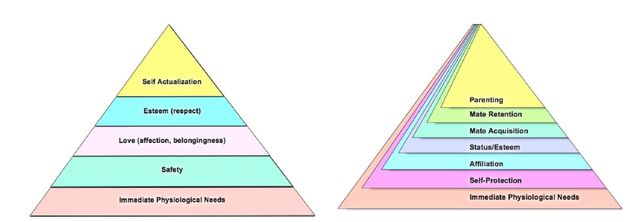Relationships
Do You Have to Be Self-Centered to Be Self-Actualized?
How would you reach your highest potential?
Posted June 25, 2017
Let’s talk about you for a minute. If you were self-actualizing right now – realizing your highest potential – what exactly would you be doing?
Remember Maslow’s pyramid of needs from introductory psychology? That’s the idea that we progress through a series of motivational steps; first we need to satisfy basic physiological needs like hunger and thirst, then we need to worry about safety, followed by social needs – for affection and respect. Maslow argued that, with all those basic needs met, we would then move on to “self-actualization” which he defined as: “the desire to become more and more what one is, to become everything that one is capable of becoming.”
Even if all these [physiological, safety, and social] needs are satisfied, we may still often (if not always) expect that a new discontent and restlessness will soon develop, unless the individual is doing what he is fitted for. A musician must make music, an artist must paint, a poet must write, if he is to be ultimately happy. What a man can be, he must be. This need we may call self-actualization. (Maslow, 1943, pp. 382-383).
Maslow’s viewpoint was a precursor of modern evolutionary approaches to behavior, in that he rejected the view that most of our adult desires were simply learned through conditioning experiences with our mothers and other role models. His approach was what we would today call “domain specific” or “modular,” in that he posited multiple motivational systems that operated on somewhat different rules. But my colleagues and I have argued that Maslow’s pyramid, now over a half a century old, needed a renovation, to reflect later theory and research.

One of our suggestions was that it seemed unlikely that our ancestors would have evolved to satisfy all their physiological and social needs, only to desire to go off and play the guitar alone in the woods, or paint pictures for our own self-entertainment. Instead, those “higher” pursuits might in fact work towards the end of increasing our connections with others, who are likely to reward creativity and intellectual understanding with respect. Indeed, creative pursuits have been found to increase your mate value. Vlad Griskevicius, Bob Cialdini found in one series of studies that thinking about romance led people, especially men, to flaunt their creativity.
In a paper fresh off the presses, Jaimie Arona Krems, Rebecca Neel and I followed up on those suggestions by asking people to think about the question we just asked you: What would you be doing if you were self-actualizing (or fulfilling your highest potential) right now? One person said: ““If I were self-actualizing right now, I would have a job in performance—probably theater. I would be a successful, admired, wealthy stage actor, maybe on Broadway. I would also have many strong, close friendships.” Another said: ““I would be working in a big corporation making websites and making lots of money. I would be very active in my community people would be looking up to me.”
If you were a subject in this experiment, you would next be asked to go back and look at your answer, and then to rate the extent to which your self-actualizing pursuits would be linked to the 7 fundamental motives: self-protection (“keeping yourself safe from physical harm”), disease avoidance (“keeping yourself healthy, avoiding illnesses”), affiliation (“making friends and allies, maintaining friendships, being accepted, being part of a group”), status-seeking (“pursuing prestige and/or dominance, being well-regarded by one’s peers”), mate acquisition (“finding one or more persons to have romantic relationships [and/or sexual intercourse] with”), mate retention (“maintaining a romantic relationship with your partner, holding on to your romantic partner”), and kin care (“taking care of your own children [or perhaps nieces, nephews, family in general], spending time with family”).

People’s responses are graphed in the figure. Men's are the dark bars, women's are the white bars. You will note that both sexes associated self-actualizing pursuits with the goal of attaining status. This was true across 3 studies, and held for college students and for older adults. Next in importance was affiliation: when people are self-actualizing, they are working to attain status and friendship.
There were also some important qualifications on this general pattern: Status was relatively less important for women than for men, for older people than for young people, and for people with children. Women with children in fact rated winning status as less important than caring for kin in achieving self-actualization, and men with children rated the two goals equally important. Kin care was especially important to self-actualization for people with younger children.
Self-actualization isn’t the same as finding meaning in life, maximizing your pleasure, or even achieving a sense of well-being. We asked some people what they be doing if they were pursuing other forms of fulfillment: (1) “eudaimonic well-being, which is about finding meaning and purpose in life”; or (2) “hedonic well-being, which is about maximizing the amount of pleasure in your life (and minimizing the amount of pain)”; or (3) “subjective well-being, which is about maximizing the extent to which your life, work, health, and social relationships are desirable, enjoyable, and valuable.” Status was not paramount for any of these pursuits (see "How is self-actualization different from finding meaning in life?").
Some psychologists might argue that it’s a mistake to ask everyday people about self-actualization, since only a small percentage of the population would ever meet Maslow’s threshold for being fully self-actualized. On the one hand, I’d argue that line of reasoning is a just a little elitist. And on the other hand, if you look at the people who Maslow himself viewed as self-actualized, they were certainly a group that excelled in both gaining status and winning friends, right in line with the intuitions of our everyday subjects. Maslow’s list included Abraham Lincoln, Albert Einstein, Thomas Jefferson, Eleanor Roosevelt, Aldous Huxley, Walt Whitman, and Mother Theresa.
Douglas Kenrick is author of:
The Rational Animal: How evolution made us smarter than we think and
Sex, Murder, and the Meaning of Life: A psychologist investigates how evolution, cognition, and complexity are revolutionizing our view of human nature.
Related blogs:
How is self-actualization different from finding meaning in life?
Rate yourself on the new motivational pyramid.
Rebuilding Maslow's Pyramid on an Evolutionary Foundation.
Self-actualization Dethroned: Did we murder Maslow's sacred cow?
References:
Griskevicius, V., Cialdini, R.B., & Kenrick, D.T. (2006). Peacocks, Picasso, and parental investment: The effects of romantic motives on creativity. Journal of Personality and Social Psychology, 91, 63-76.
Kenrick, D.T., Griskevicius, V., Neuberg, S.L., & Schaller, M. (2010). Renovating the pyramid of needs: Contemporary extensions built upon ancient foundations. Perspectives on Psychological Science, 5, 292–314.
Krems, J.A., Kenrick, D.T., & Neel, R. (2017). Individual perceptions of self-actualization: What functional motives are linked to fulfilling one’s potential? Personality and Social Psychology Bulletin. In press.
Maslow, A. H. (1943). A theory of human motivation. Psychological Review, 50, 370




